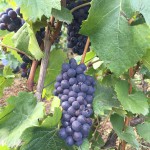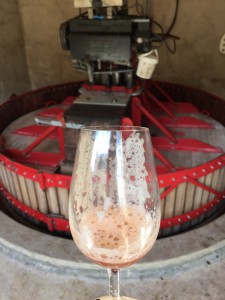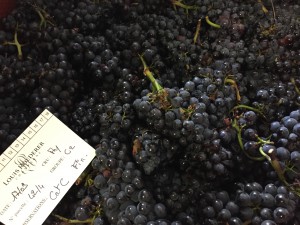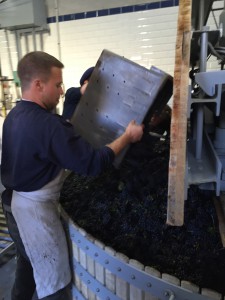I tasted both juices, Les Longues Viols as it ran off the press and Les Hautes Chèvres as they were being racked and love the precision and tension the juice has this year. I feel the balance between the sugars and acidity is extremely harmonious; in fact both juices were very morish, and that means a lot from a person who has never been too crazy of grape juice ;-)
I also spoke to Vincent’s uncle François, who has vineyards worked organically by Vincent and conventional vineyards worked by another service provider. According to François there is a difference in quantity, with conventional vineyards averaging about 30% higher yields. This was echoed the next day by Johann Merle and Jean-Baptiste Lécaillon of team Roederer, though it seems that Roederer has suffered bigger losses in Cumières. “We average around 5,500 kg/ha in Cumières and Aÿ; but these are our oldest vines so the quantities will go up when we harvest younger vines”, says Johann. Jean-Baptiste added: “After a lot of internal discussion we decided to apply a (chemical) antibiotic at time of flowering for all our vineyards bar the 10 hectares which are certified organic. A second dose was applied just after flowering, and afterwards the teams went back to treating with copper and sulphur. As soon as we applied the product, the situation stabilized, whilst we had around 20% more loss around flowering in our organic vineyards.” As Roederer had not begun to harvest the organic vineyards on Saturday, they could not give exact yield numbers. The vineyards will be harvested tomorrow and Tuesday – both flower days and I will go and have a look and taste at that time :-)
Roederer started the harvest in Cumières and Aÿ on Thursday and in Verzennay on Friday. They will not open their press centre in Avize till the 22 or 23rd, a few days after the official starting dates. Apparently many growers are not very happy about his decision, but they will have to wait till Jean-Baptiste and Johann feel the time is right to pick. Jean-Baptiste elaborates: “Normally we need to be very careful and precise with the Pinot’s from the Montagne de Reims. This time we will have to pick the right dates for the Chardonnay. I prefer to wait and pick the fruit ripe. In another week we will be closer to that time.” It is the first time since the forties that Roederer opens its press centre in Verzennay before Avize; in fact, in 2014, they had closed Avize before they started in Verzennay :-) Both Jean-Baptiste and Johann are very happy about the quality as well, and especially about the balance in the juice and the potential alcohol levels, which average between 10.5 and 11.5%. I tasted some Pinot Noir which ran off the press, one lot from young vines replanted from clone massale in Aÿ and another glass from older vines in Mareuil-sur-Aÿ. The Aÿ juice was amazing with a beautiful finesse! I also tasted many Pinot Noir grapes both at the press centre (grapes were waiting to be loaded in the press) and in the vines in Hautvillers and Aÿ and again there was a lovely balance and plenty of sugars. Jean-Baptiste explained: “It is amazing but after only 80 days the grapes have reached full maturity, the skin is crunchy, the pips are ripe and there is no bitterness left. The fruit is ripe and will not change in sugar levels anymore; if we do not pick now we will just loose acidity.” His namesake Jean-Baptiste Geoffroy said the same thing almost word for word later on Saturday afternoon when speaking about his Meuniers and Pinot’s. As I arrived the press was just being loaded with Meunier and I tasted the free-flow running off the press. The juice came in at 10.7% potential alcohol and again it had a great freshness. I should note here that acidity levels in Meunier are generally lower than the other two grape varieties, but according to Jean-Baptiste they are in line with the Pinots up till now. The Geoffroys began to pick in Cumières on Thursday as well, and the press loads has come in between 10.3% and 11.8% potential alcohol, with an average yield of 8,000 kg/ha. All grapes come from Cumières bar 2 plots which were picked in Hautvillers on Friday to make the Blanc de Rose. Jean-Baptiste fears that the vineyards in Fleury-la Rivières will be more complicated as they were particularly hard hit with mildew in June, but all in all he is quite happy.”I cannot complain, the quantity is a little less but we are harvesting some exceptionally beautiful grapes!”, exclaims Jean-Baptiste. I am very happy he decided to make a little amount of Coteau Champenois Rouge for we both agreed that this year would be excellent for still wines. But as Jean-Baptiste explains:”If I make a lot of red wine I will not be able to make enough champagne…” The Pinot for the red came in at 11.8% potential alcohol and I was blown away when I tasted the macerating grapes in the cask: amazing freshness, rosewater and hibiscus notes with tart red fruit. This is a Coteau Champenois I will stock up on in a few years time!Whilst I was there team Geoffroy destemmed some more Pinot to make the Rosé de Saignée, and once again I had no problem drinking several sips, pulp, skins and all!! So after two days tasting different Meuniers and reds from Cumières and Aÿ, I can but say 2016 is very quickly getting under my skin.




